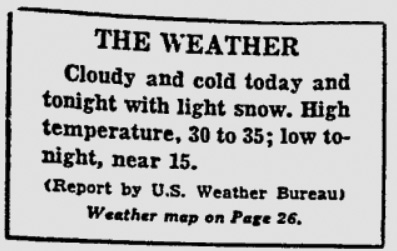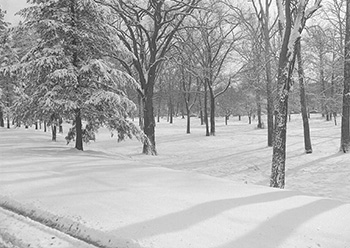Weather forecasting in the 21st century is light years away from 1951. There wasn’t any radar. Forecasters on television and the radio relied mostly on what was then known as the U.S. Weather Bureau (today’s National Weather Service).

Even in the old days when I was watching television, local TV stations didn’t have meteorologists: it was Frank Venner at WSPD, rolling out a glass map of the U.S. and drawing on it outside the studios at 136 Huron St., and WTOL had Joe Ashton, who also hosted Dialing for Dollars.
It took the likes of Charles Merlin Umpenhour who, according to his obit, was the first meteorologist hired to do television weather in Toledo, to shake things up. Stan Stachak (he retired in 2012 from WTVG after 30 years) was not far behind, nor was the legendary Merle Kachenmeister.
Detroit had Sonny Eliot, who was in a class by himself, and he was always worth a look on WWJ/WDIV, channel 4.

Readers of The Blade got a map, data, all the weather stories they could handle, and this little forecast box on the front page every day. This particular forecast was from Christmas Day, 1951, and nobody apparently saw what was coming.
December, 1951 had already been a snowy month in Toledo. 15.9 inches of snow had already fallen, and Toledoans were surprised on Christmas Day to receive another 9.7 inches of snow, breaking the previous December record of 23.5 inches set in 1895.
The timing was perfect, however. “The Christmas holiday, which kept most residents home with relatives, was credited with saving the city from one of the most acute breakdowns of private and public transportation facilities in recent years,” The Blade said. Nevertheless, the snow was blamed for two deaths, three heart attacks, and falls injuring 13.
Even the yearly snowfall record at the time – 51.9 inches in 1886 – was in danger (2014 made quick work of that record when 86.3 inches of snow fell). December 1951 wound up having the second-highest snowfall total in Toledo history (25.5 inches), topped only by the 26 inches in 2000.
As Toledo went back to work on Dec. 26, drivers encountered impassable roads, snowbound cars and piles of snow everywhere. Parking was banned on the north and west side of streets in the central business district, and Community Traction buses plodded through the streets with heavy loads as drivers left their cars at home and opted for mass transit.
By Friday the 28th, traffic on main roads was “getting back to normal” and city crews, with the help of the county, began clearing residential streets. The Blade took time to point out the difference between the city’s efforts and the county’s response by showing photos of Cheltenham Road in the Old Orchard area – the county part was fairly clear while the city’s part was mostly untouched. “The difference in street conditions prompted newly annexed citizens of the city to complain,” The Blade said. While complaining about the general ineffectiveness of traffic cops to accomplish much of anything, an editorial uncorked a stunning note: “The city, which didn’t even have a snow plow three years ago, is fairly well prepared now to handle the sort of snowfall we generally experience.” Really?
The next day, The Blade predicted the snow would soon be turning to slush thanks to a high of 45 degrees.
It would be another 14 years – February 25, 1965 – until Toledo saw a similar snowstorm as bad as Christmas Day, 1951.
Note: the featured image is of Willys Park in 1954, courtesy of the Toledo-Lucas County Public Library, obtained from http://images2.toledolibrary.org/. There weren’t any 1951 snowstorm photos to go around. It’s just pretty.

I remember watching the weather by Frank Venner in front of the Commodore Perry Hotel when I was a kid